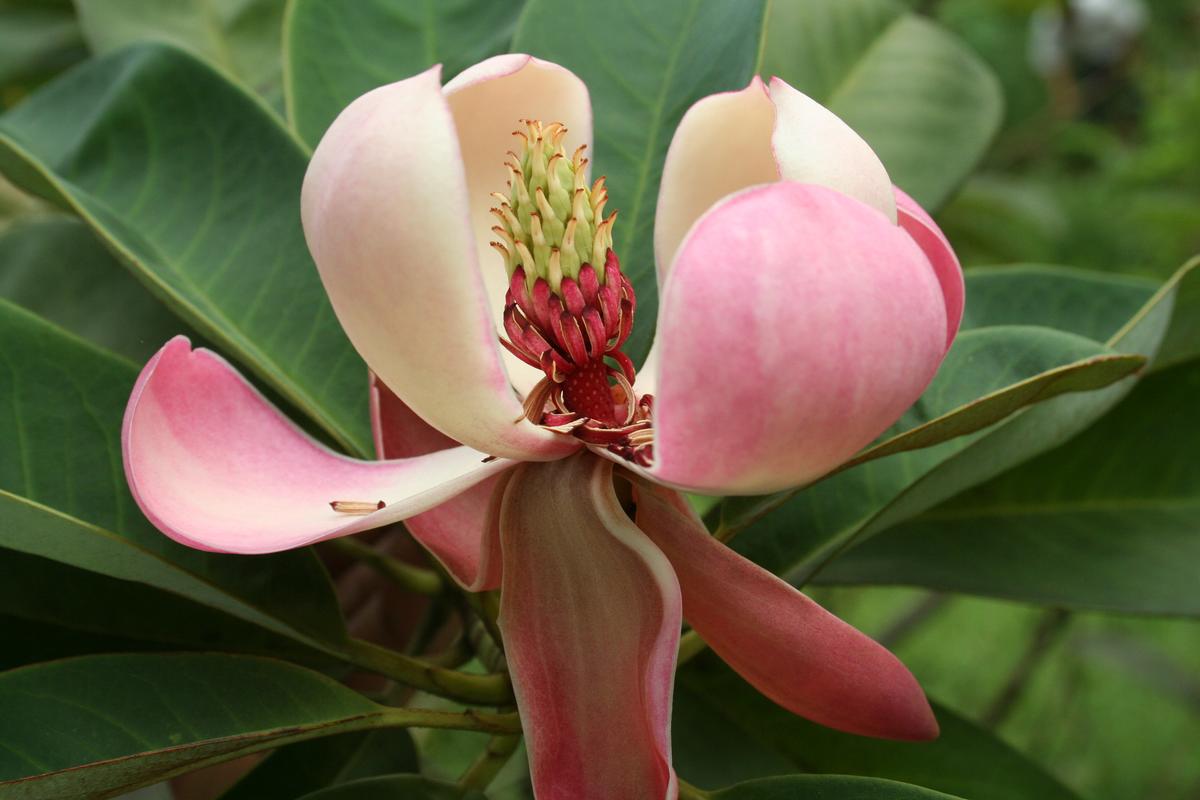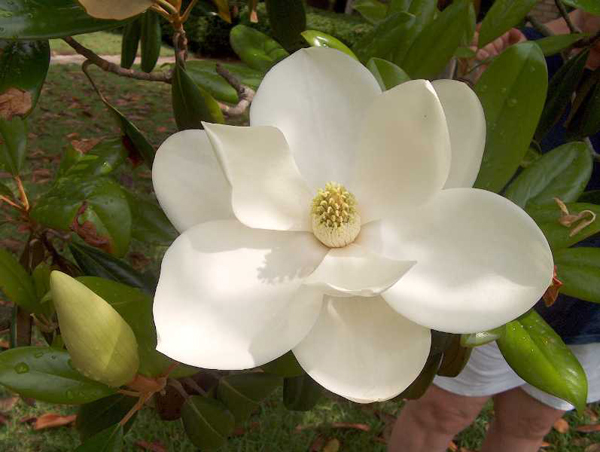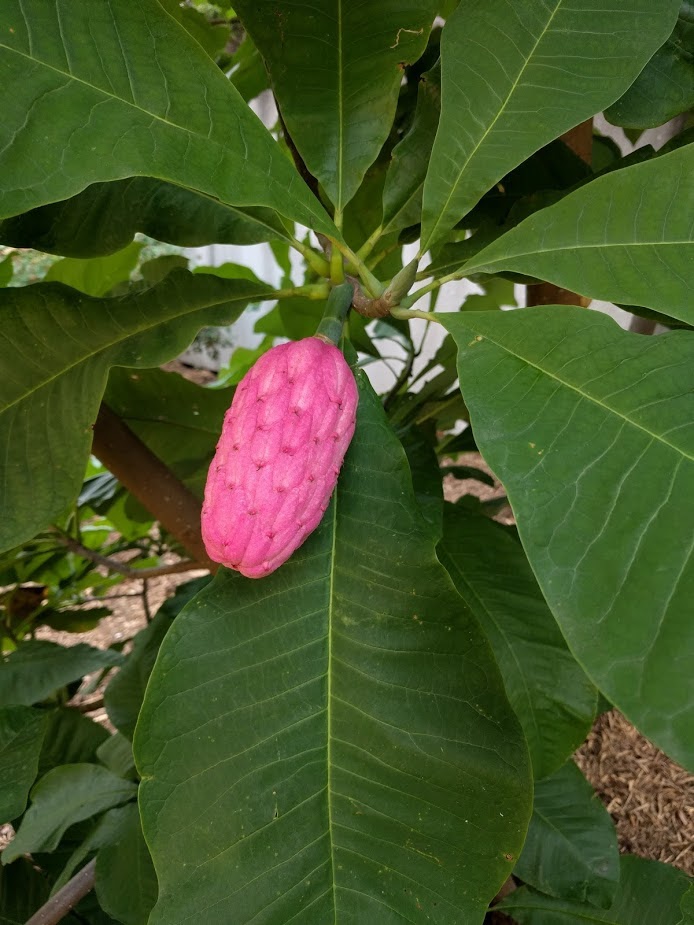Common Name: magnolia
Scientific Name:
Family: Magnoliaceae
Genus: Magnolia
Species: spp.
Hardiness Zone:
Height: up to 80 ft
Width:
Common Characteristics:
Magnolias are a multi-stemmed or single trunk shrub/tree. A lot of the smaller-sized magnolia cultivars are shrub-like. Most magnolia hybrids have smooth gray bark. Their leaves are simple and alternately arranged. They tend to be dark green in color. They have large, beautiful cup-shaped flowers that vary in color and bloom in the spring before the leaves break bud. Magnolias do not produce nectar and are typically pollinated by beetles. The fruit of the tree is a pickle-shaped aggregate that matures from green to pink and then red. When it matures, it opens to reveal seeds.
Where it Grows:
For best flowering potential, plant magnolias in the spring in a sheltered location to avoid wind damage. Select late-blooming varieties to avoid frost damage. They do best in well-drained soils and full sun but may prefer partial shade in hot summer areas. They are not drought tolerant and require deep, thorough watering. A layer of mulch will help conserve moisture and moderate soil temperature.
How it's Used:
They are widely used as landscape trees and shrubs.
Ecosystem Services:
Songbirds use magnolias for shelter and as a food source. Squirrels, opossum, quail, wild turkeys, and deer will eat the leaves, barks, and twigs of the tree. Beetles are attracted to flowers.
Where it is Native to:
There are around 80 species of magnolia all around the world in Asia, the Caribbean, Central, North, and South America.
Known Varieties and Their Traits:
-
Ann magnolia (Magnolia ‘Ann’): This cultivar grows 8 to 10 feet high and wide. It has an upright shrubby form and blooms in mid-April. It can be grown as a shrub or small tree with an open habit. It is erect and has tapered buds opening to red-purple flowers. One of the little girl series. Zone 4-8
-
Ballerina Loebner’s magnolia (Magnolia x loebneri ‘Ballerina’): Growing 15 to 20 feet high and wide this cultivar has a rounded form and blooms early to mid-April. Flowers have numerous pure white petals that are pale pink at the base. Zone 4-8.
-
Betty magnolia (Magnolia ‘Betty’): Growing 10 to 15 feet high and 8-12 feet wide this upright cultivar has a shrubby form and blooms in mid-April. Can be grown as a large shrub to a small tree. New leaf growth emerges copper-red changing to medium green with flowers of deep purple-red with white interior. Zone 4-8.
-
Butterflies magnolia (Magnolia ‘Butterflies’): This cultivar grows 18 to 20 feet high and 12 to 18 feet wide. It grows in an upright, pyramidal form and blooms in late May. It is a small tree with deep yellow flowers that appear before the leaves. Zone 5-7
-
Coral Lake magnolia (Magnolia ‘Coral Lake’): This cultivar has upright flowers with a mix of pink, peach, coral, and cream and they are fragrant. It flowers later than some magnolias and grows 20 feet high. Zone 4.
-
Daybreak magnolia (Magnolia ‘Daybreak’): A narrow cultivar with rosy pink flowers grows 20 to 25 feet high and 6 to 12 feet wide. Zone 5-8.
-
Elizabeth magnolia (Magnolia ‘Elizabeth’): Growing 30 to 50 feet high and 20 to 35 feet wide, this upright cultivar has a pyramidal form. It blooms in mid-May and is a vigorous large tree with primrose yellow flowers. It blooms at an early age. Zone 4-8
-
Galaxy magnolia (Magnolia ‘Galaxy’): Growing 20 to 25 feet high and 12 to 15 feet wide, this Cultivar can take a rounded to pyramidal form. It grows as a small tree with pink flowers that bloom in late April. Green leaves turn a coppery bronze in fall. Zone 4-8.
-
Goldfinch magnolia (Magnolia ‘Goldfinch’): This cultivar grows 35 to 40 feet high and 30 to 40 feet wide. It has an upright, pyramidal form and blooms in early May. It is a mid-size tree with light yellow flowers that bloom before the leaves emerge. Zone 4-8
-
Gold Star magnolia (Magnolia ‘Gold Star’): This cultivar grows 20 to 25 feet high and 15 to 20 feet wide. It has a broad, pyramidal form and blooms in early May. It is a small, multi-stemmed tree with star-shaped, yellow flowers. New leaves emerge bronze-colored. Zone 4-8
-
Jane magnolia (Magnolia ‘Jane’): Growing 8 to 10 feet high and wide, this cultivar takes an upright, shrubby form. It blooms in mid-May. Flowers are cup-shaped and are reddish-purple outside and white inside. It is one of the little girl series. Zone 4-8
-
Leonard Messel Loebner Magnolia (Magnolia x loebneri ‘Leonard Messel’):Growing 25 to 30 feet high and 30-35 feet wide, this cultivar has a rounded form. It blooms in early to mid-April. Its dark purple flower buds open with a white interior. Zone 4-8
-
Merrill Loebner Magnolia (Magnolia x loebneri ‘Merrill): Growing 25 to 30 feet high and 30 to 35 feet wide, this cultivar has a rounded form and blooms early to mid-April. It is a fast-growing tree with many strap-like petaled white flowers. Zone 4-8
-
Ricki magnolia (Magnolia ‘Ricki’): Growing 8 to 10 feet high and wide, this cultivar has an upright form. Its deep purple buds produce fragrant, strap-like white petals with fuchsia shading that opens before the leaves. It is one of the little girl series. Zone 4-8
-
Sunsation magnolia (Magnolia ‘Sunsation’): Large (6 to 7 inches wide) creamy-yellow flowers accented with a blush of pink bloom on this cultivar. It grows 20 to 30 feet high and 20 to 25 feet wide. Zone 4.
-
Yellow Bird magnolia (Magnolia ‘Yellow Bird’): This cultivar has yellow, upright flowers that are produced later than some cultivars. The plant grows up to 40 feet high and 25 feet wide. Zone 4-8.
References:
'Magnolias'. The Missouri Botanical Garden. Found online: https://www.missouribotanicalgarden.org/gardens-gardening/our-garden/notable-plant-collections/magnolia.aspx
'Magnolia'. Morton Arboretum. Found online: https://mortonarb.org/plant-and-protect/trees-and-plants/magnolia/#overview
'Magnolia - Magnolia spp.'. University of California Agriculture and Natural Resources. Found online: http://ipm.ucanr.edu/PMG/GARDEN/PLANTS/magnolia.html
'What animals use magnolia trees?'. SF Gate. Found online: https://homeguides.sfgate.com/animals-use-magnolia-trees-85859.html


